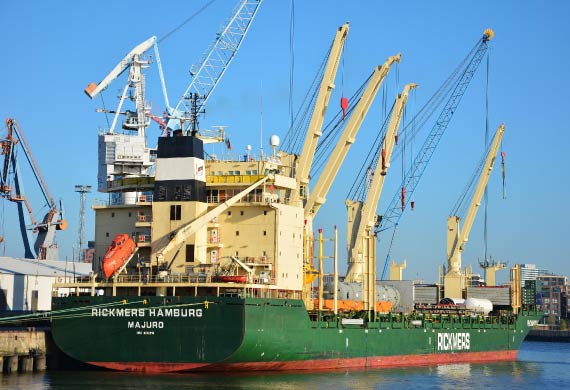
Port of Hamburg Staying on course
A leading universal port, the Port of Hamburg offers tremendous insight into technological innovation and best practices. Lionel Alva… The Port of Hamburg is considered as being among the biggest and most important ports in the world. In terms of TEU throughput, Port of Hamburg holds the coveted position of being second busiest port in Europe […]

A leading universal port, the Port of Hamburg offers tremendous insight into technological innovation and best practices. Lionel Alva…
The Port of Hamburg is considered as being among the biggest and most important ports in the world. In terms of TEU throughput, Port of Hamburg holds the coveted position of being second busiest port in Europe (after the Port of Rotterdam) and 15th-largest worldwide.
The port is located at a geographically advantageous position of 115 kilometres or 70 nautical miles from the North Sea following the Elbe River, right in the middle of the greater Hamburg area. Its environmental-friendly inland position helps shipping lines and freight forwarders to reduce transport time by truck or rail. The Port of Hamburg – and the EUROGATE Container Terminal Hamburg – is located in the southern part of the city. The North Sea and the Elbe River are tidal waters.
Since Hamburg with its strong Baltic trades handles an around six percentage points higher proportion of transhipment cargo than the ports of Antwerp or Rotterdam.
As a universal port; the Port of Hamburg handles all cargo categories from containers, dry and liquid bulk to general cargo. At a share of 70 percent general cargo and container handling represent the key segments.
In 2014, 9.73 million TEUs were handled in Hamburg. It holds the distinction of being among the largest trans-shipment centres in the world for tea, cocoa, coffee and spices. It is also Europe’s largest marketplace for pharmaceutical raw materials.
The port is also a pioneer for smart port logistics and is among the foremost ports to seek ways to enhance technological implementation, connectivity while constantly striving towards innovation.
“Smart Port Logistics and smart port development in Hamburg requires a certain amount of courage and a great deal of innovation thinking. The Hamburg Port Authority (HPA) developed a smart port philosophy which combines both. Modern IT-supported transport and communications systems to accelerate traffic and trade flows in the port area and coordinate them more efficiently,” says Axel Mattern, CEO, Port of Hamburg Marketing.
The Hamburg Port Authority is also committed towards using renewable energy and saving resources in the port. In this way, the port can grow in a sustainable manner and remain one of the key economic drivers for Hamburg.
One example is the floating power plant for the port. This year the first floating liquefied natural gas power plant started operations in the port. This new floating power plant is equipped with LNG powered engines and five generators that supply low-emission electricity to cruise ships in the Port of Hamburg.
The port currently offers three terminals to handle cruise ships. Around 160 cruise ship calls per year make Hamburg a leading cruise port in Germany. Hamburg is Germany’s biggest seaport and has terminals for handling all kind of cargo.
A large part of the cargo for/from China and Russia is transhipped via Hamburg, being transferred from large containerships on to feederships, or vice versa. Approximately 10,000 ships a year use the Port of Hamburg. The favourable geographic location of the Port of Hamburg 130km inland from the open sea substantially reduces the need for expensive and less environmentally friendly road travel. Moreover, the Port of Hamburg offers the most frequent feeder services to the Baltic Sea area, whereby Hamburg as the most eastern port of the North Range benefits from its proximity to the Kiel Canal and the Baltic Sea economic area. The planned expansion of the canal to accommodate larger ship sizes will further increase the cost-effectiveness on this route. From the ecological point of view, waterway transports are generally a lot more favourable than road transports. The deployment of new large vessels further decreases energy consumption as well as pollutant and CO2 emissions per cargo unit moved.
Mattern highlights, “The number of ultra-large containership calls rose again in the first half of 2015. Those with slot capacity of up to 13,999 TEU made 255 calls, or 18 percent more, and ships with over 14,000 TEU, 53 calls, or 96 percent more. The still not implemented dredging of the channel of the Lower and Outer Elbe must not become a competitive handicap for Germany’s largest port. Container terminals are already prepared to handle these mega ships in Hamburg.”
Since global trends delineate increasing levels of contanerisation and the advent of megaships or large vessels, one of the Port of Hamburg’s biggest projects in recent times has been to dredge the River Elbe from the open sea to Hamburg in order to pursue the development and growth targets of the Germany’s largest universal port. However, these plans have hit a roadblock as a recent European court ruling hits Bremerhaven and Hamburg’s dredging plans.
Furthermore, the recent half-year figures show how essential it is to implement the still outstanding dredging of the navigation channel to facilitate improved handling of ultra-large vessels, so that large quantities of transhipment cargo should continue to come to Hamburg, rather than being handled in other ports in the North Range because restrictions on the Elbe limit exploitation of mega-ships’ transport capacities.
Mattern adds, “Following dredging of the navigation channel, an especially large containership could transport up to 1,800 more loaded containers (TEU) both inbound and outbound when calling Hamburg.The European Court of Justice handed over the decision concerning dredging of the river Elbe navigation channel to the German Federal Administrative Court (FAC) in Leipzig. A final decision we expect from the German court next year.”

